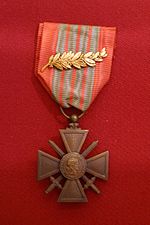106th Cavalry Group (United States)
| 106th Cavalry Group | |
|---|---|

106th Cavalry Regiment coat of arms
|
|
| Active | 1942–1945 2006–present |
| Country | United States |
| Branch | Army National Guard |
| Type | Cavalry |
| Role | Reconnaissance and surveillance |
| Size | Regiment |
| Motto(s) |
Utcumque Ubique Anywhere at Any Time |
| Colors | yellow, red |
| Equipment | Bantam jeep, M8 Greyhound, M5A1 Stuart, M24 Chaffee |
| Engagements |
World War II Normandy Rhineland Ardennes-Alsace Central Europe |
| Decorations |
Distinguished Service Cross (1) Legion of Merit (1) Legion of Honor (1) Croix de guerre (16) Silver Star (58) Bronze Star Medal (519) |
| Battle honours | 121st CRS: Fourragère 121st CRS: French Croix de guerre with Palm 106th Group: French Croix de guerre with Palm |
| Commanders | |
| Notable commanders |
Colonel Vennard Wilson Colonel Paul Hastings |
| Insignia | |
| Distinctive unit insignia |  |
| U.S. Cavalry Regiments | |
|---|---|
| Previous | Next |
| 105th Cavalry Regiment | 107th Cavalry Regiment |
| Croix de guerre 1939–1945 | |
|---|---|

French Croix de guerre of World War II with one gilt palm
|
|
| Awarded by France |
|
| Type | Medal |
| Awarded for | Military duty during World War II mentioned in Despatches |
Colonel Vennard Wilson
The 106th Cavalry Regiment (formerly organized as a group) was a mechanized cavalry unit of the United States Army in World War II recognized for its outstanding action. The group was organized in 1921 as part of the Illinois National Guard and during the Spanish–American War and World War I was known as the 1st Regiment Illinois Volunteer Cavalry. It underwent a number of reorganizations before World War II. Like other Guard units during the inter-war years, the 106th held monthly drills and yearly training. Readiness for war in 1940 led to the mechanization of the unit and induction into Federal Service at Camp Livingston, Louisiana on 25 November 1940.
After the Pearl Harbor attack, the 106th trained at Camp Hood, Texas until the spring of 1944 when they deployed to Europe. Upon arriving in England, the group was reorganized into the 106th and 121st Cavalry Reconnaissance Squadrons along with a Group Headquarters. When they were moved to Europe, they were often in the lead of other units. Lightly armed, they scouted ahead to fix enemy locations. For the next year and a half, they fought through France, Luxembourg, Germany and Austria, earning five campaign streamers and the Croix de guerre from Charles de Gaulle, President of the Provisional French government. The regiment lead the Allied advance across the Rhine and were the first unit to attack a town south of the Siegfried Line or West Wall.
In late 2006, the 33rd Brigade Combat Team of the Illinois Army National Guard was formed and the 106th Cavalry Squadron was included in the reorganization.
The 106th Cavalry was before World War II a National Guard unit based in Chicago, Illinois. Prior to World War I and the Spanish–American War it had been known as the 1st Illinois Volunteer Cavalry. The 106th underwent a number of different reorganizations until 1 September 1940, when it was redesignated the 1st Squadron, 106th Cavalry (Horse-Mechanized). The 106th was inducted into federal service on 25 November 1940 in Chicago. The Regiment moved to Camp Livingston, Louisiana on 3 January 1941 under command of V Corps.
...
Wikipedia
